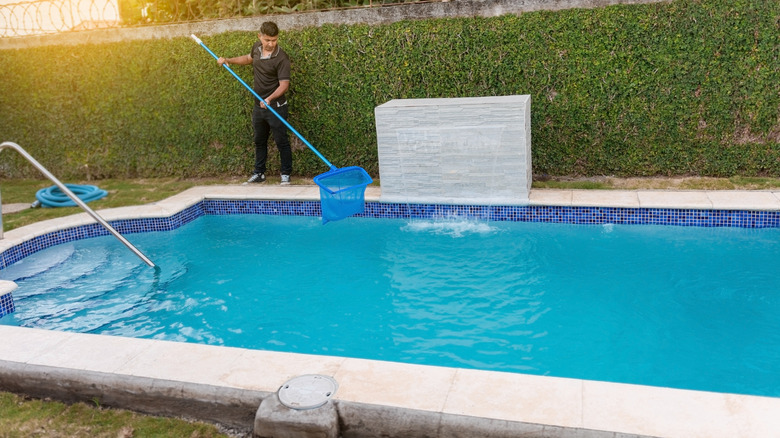How To Shock A Pool With Bleach
The purpose of shocking a pool is to quickly increase the concentration of free available chlorine. You can do this with a commercial product, which works partly by freeing the chlorine that has already formed compounds with contaminants. You can also simply add more chlorine, and pouring household bleach into the pool is one way to do this. Be sure the pH is in the proper range — between 7.2 and 7.8 — and add the bleach in the early evening to avoid having most of it degraded by sunlight.
Cloudy or green pool water is a sign that the level of free available chlorine in the pool is too low to provide proper sanitation. When you test the water, you'll probably find that the concentration of free available chlorine is has fallen below the recommended value of 1 part per million, and this may be despite the fact that the total chlorine concentration is within acceptable limits. This happens when much of the chlorine has formed compounds — called chloramines — with bacteria and other contaminants and is no longer available for sanitizing. Chloramines emit an odor, so the pool may actually smell of chlorine, even when the free chlorine concentration is low.
Using Bleach as a Shock
Commercial pool shock often contains chlorine, but it typically also contains chemicals that replace the chlorine in the compounds it has formed and render it available for sanitizing. You need to use less of such products per volume than you do if you simply add chlorine, and if you opt for chlorine alone, you need more bleach than you do pool chlorine.
Bleach contains the same chemical — sodium hypochlorite — as pool chlorine, but the concentrations are different. The concentration of sodium hypochlorite in pool chlorine is between 10% and 15%, whereas in bleach it's only between 5 and 6 percent. That means you need at least twice as much bleach as pool chlorine, and considering that the goal of shocking is to raise the free chlorine concentration (temporarily) to 5 to 10 parts per million, that could add up to a lot of bleach.
There's one other thing to consider: chlorine quickly degrades in sunlight. Your pool may already have a high enough concentration of cyanuric acid — a chlorine stabilizer — to prevent degradation, and if it doesn't, you should add more. Even if the cyanuric acid concentration is within acceptable limits, it's best to add the bleach in the late afternoon or the evening to give it time to work in the dark.
How to Shock the Pool With Bleach
Step 1
Test the pH of the pool water and add muriatic acid or sodium bisulfate to lower it if it's too high. Chlorine quickly loses its effectiveness when the pH is above 7.8. Ideally, the pH should be between 7.2 and 7.8.
Step 2
Use your test kit to check the level of cyanuric acid in the pool. It should be between 20 and 50 ppm. If it's too low, add a stabilizer to the pool water to raise the concentration. Follow the directions on the container of the stabilizer product you use.
Step 3
Measure the volume of your pool to determine how much bleach you need. Multiply the width of the pool by the length, and multiply again by the average depth of the water to find the water volume. Calculate the amount of bleach you need based on the fact that 1 gallon will raise the free chlorine level of 30,000 gallons of water by 2 parts per million. If you need to mildly shock a 30,000-gallon pool by raising the free chlorine concentration to 5 parts per million, you need 2.5 gallons of bleach. To raise it to 10 ppm, you need 5 gallons.
Step 4
Add the bleach to the pool during the late afternoon or early evening. Pour it in along the edge of the pool as you walk around the perimeter — never pour it into the skimmer. Circulate the water for several hours after adding the bleach, to be sure it gets completely mixed.
Tip: You should shock your pool after a period of heavy use, after extended periods of hot, sunny weather or after a heavy rain. You should also shock, paradoxically, when the water smells of chlorine. That means that the chloramine concentration is too high.
